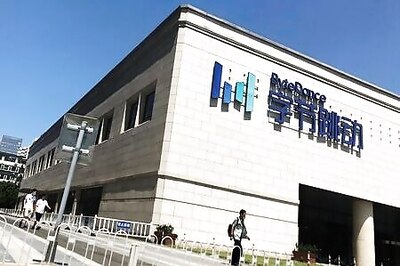
views
Tokyo: After a delay of more than three years, Boeing's much-hyped jet, the 787, made its first commercial flight, from Tokyo to Hong Kong - and landed on-time.
The All Nippon Airways flight was packed mostly with aviation reporters and enthusiasts, some of whom paid thousands of dollars for the privilege and treated the experience like a rock concert, clapping after lift-off and snapping photos for posterity.
"It's silly, but it's a little piece of history. New cars come out all the time but how often do new planes come out?" said Stephanie Wood. She and her husband, Dean paid close to $19,000 in a charity auction for two business-class seats.
The 787, which is nicknamed The Dreamliner, is neither the fastest nor largest jet. But it is built out of ultra-lightweight materials and promises to be 20 per cent more fuel-efficient than comparable aircraft, a big deal at a time of high oil prices.
Boeing is also pitching its 787 as a major upgrade for travelers. It was designed with larger windows, more space in overhead bins and improved lighting. The jet was also designed to provide air pressure and humidity levels that more closely resemble those on the ground, a feature that Boeing says will ease jet lag.
The 787's inaugural flight came more than three and a half years late because Boeing was plagued with manufacturing problems. Parts for the jet are made by 52 suppliers scattered around the globe. And, in a first for Boeing, large sections of the jet are built by these outside vendors and then cobbled together.
That process, aimed at saving money, has not been as smooth as hoped. Instead, Boeing has been plagued by delays that have forced it to pay airlines millions of dollars in penalties.
Boeing, which has a backlog of nearly 800 787s, said on Wednesday that fewer of the jets - six at the most - would be delivered this year than previously forecast.
Boeing also faces pressure from European rival Airbus which is designing its own lightweight composite jet, the A350. That plane is still several years away from flying.
The most noticeable feature of the 787 for fliers is its windows, which are 30 per cent larger than those on older jets. Passengers no longer need to hunch forward to see the ground. Those in the middle of the plane can even glance out part of the windows. Instead of shades, the windows come equipped with a glare-reducing, dimming system.
Other design features that stand out include:
- A roomier feel. Because passengers enter into a wide-open area with sweeping arches, claustrophobia is reduced just a bit, even if seats are as cramped as ever.
- Huge overhead bins. Boeing says there's enough room for every passenger to have one carry-on bag.
- Less noise. New engines with a wave pattern around the exhaust reduce interior and exterior noise, although Boeing won't say by how much. Wednesday's flight seemed quieter, but a handheld sound meter registered noise levels similar to Boeing's 777.
Because the composite materials the jet is built from are stronger and less likely to rust than traditional materials, Boeing says that the air inside its 787s won't be as dry, with humidity doubled to 16 per cent. And it says the cabin will be pressurized at a lower level. These changes should lead to fewer headaches and leave passengers with more energy during long trips.
A number of passengers said on Wednesday's flight was too short to notice these air-quality improvements.
Many of the aviation enthusiasts on board on Wednesday's flight carried memorabilia from past inaugural flights. They snapped photos of overhead bins and even the bathroom, which is equipped with a window and bidet.
Thomas Lee, of Los Angeles, handed out his own press release and biography. There was his first inaugural flight - the Boeing 747 as a 17-year-old boy in 1970 - and then the Airbus A380 four years ago.
"I'm not crazy," he said. "For an aviation enthusiast, this is as high as it gets. It's like going to a movie on opening day."
He and the rest of the coach passengers paid 78,700 yen, about $1,035, to be part of the inaugural flight.
The 787 has been sold by Boeing as a "game changer," promising to revolutionize air travel just as its 707 did by allowing nonstop trans-Atlantic service and the 747 did by ushering in an age of mass travel.
The 787 is designed to connect cities that might otherwise not have nonstop flights. Planes like the Boeing 747 and 777 and the Airbus A380 can fly most long-haul routes but finding enough daily passengers to fill the massive jets is a challenge. The A380 typically has 525 passengers but can hold up to 853.
The 787 only carries 210 to 250 passengers. That means it can fly nonstop routes that larger planes can't profitably support like San Francisco to Manchester, England or Boston to Athens, Greece.
Connecting such smaller cities - and avoiding major hubs - is the "holy grail" of air travel, said Richard Aboulafia, analyst with the Teal Group. That's why the plane is the fastest-selling new jet in aviation history. There were 821 orders for the 787 before its first flight, although 24 were recently canceled by China Eastern Airlines because of delays.
ANA is the first airline to fly the plane and expects to have seven of them by the end of the year. United Continental Holdings Inc. will be the first U.S. carrier to fly the 787, sometime in the second half of 2012. It's planning to use the plane between Houston and Auckland, New Zealand.
Airlines are most eager to learn if the plane lives up to Boeing's claims of 20 per cent fuel savings.
"If it performs as promised, it's the iPod of the aircraft world. If it doesn't, it's just another CD player," Aboulafia said.



















Comments
0 comment